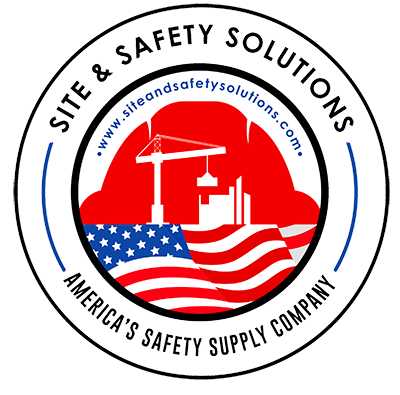
Introduction
Construction sites demand the utmost safety measures to protect the workforce. At Site and Safety Solutions, our commitment lies in providing cutting-edge products tailored to enhance safety standards.
Importance of Site Safety in Construction:
Construction sites are dynamic environments with inherent risks that demand stringent adherence to safety protocols. Considering the multifaceted hazards prevalent in such settings, the significance of prioritizing site safety must be considered.
Hazards on Construction Sites:
-
Falls:
One of the leading causes of injuries and fatalities on construction sites.
Occur due to unprotected edges, unstable working surfaces, or improper use of fall protection equipment. -
Equipment-Related Accidents:
Machinery, power tools, and heavy equipment pose significant risks.
Improper use, lack of maintenance, or malfunctioning machinery can lead to severe injuries. -
Electrical Hazards:
Exposure to live wires, faulty wiring, or inadequate grounding can cause electric shocks, burns, or even fatalities.
-
Chemical and Hazardous Material Exposure:
Handling, storage, or accidental spills of hazardous materials pose health risks if not managed properly.
Importance of Adhering to Safety Protocols:
- Risk Mitigation:
- Implementing and following safety protocols mitigates potential risks, reducing the likelihood of accidents and injuries.
- Worker Well-being:
- Prioritizing safety safeguards construction workers’ physical and mental well-being, fostering a safer and healthier work environment.
- Regulatory Compliance:
- Adhering to safety standards ensures compliance with regulations set forth by organizations like OSHA, minimizing legal liabilities.
- Productivity and Efficiency:
- Safe work in a Site Safety promotes higher productivity by reducing downtime due to injuries or accidents.
Strategies for Enhancing Site Safety:
- Training and Education:
- Regular training sessions on safety protocols, equipment operation, and hazard identification are crucial.
- Use of Personal Protective Equipment (PPE):
- Providing and enforcing the use of appropriate PPE, such as helmets, gloves, safety goggles, and high-visibility vests.
- Regular Inspections and Maintenance:
- Conducting routine inspections of equipment and structures to identify and rectify potential hazards promptly.
- Safety Culture:
- Fostering a culture that prioritizes safety encourages workers to actively participate in maintaining a safe environment.
Collaborative Efforts for Safety:
- Management Involvement:
- Active involvement and commitment from management in enforcing safety measures set a strong precedent for workers.
- Worker Engagement:
- Encouraging workers to actively contribute to safety discussions, report hazards, and suggest improvements creates a collective responsibility for safety.

Essential Safety Products Offered:
Our range of products is designed to mitigate risks and ensure a secure working environment:
-
16GA. X 3.5LB BLACK TIE WIRE:
This robust tie wire ensures the secure fastening of materials, preventing potential hazards caused by loose components.
-
Brady® GHS SDS Right To Know Compliance Center:
Facilitate compliance with safety data sheet regulations using this comprehensive compliance center.
-
Honeywell Lockout Group PadLock Lock Box:
These lock boxes are tamper-proof and red-colored for easy identification, essential in preventing unauthorized equipment access.
-
NFPA® Hazardous Diamonds:
These diamonds serve as visual aids, effectively communicating the nature of hazardous materials on-site.
-
Presco Solid-Color Roll Flagging Blue Glo, PresGlo:
Enhance visibility and mark specific areas with this high-visibility flagging tape.
Implementing Safety Measures:
Discussing best practices for incorporating these Site Safety products into daily routines. Addressing the significance of regular equipment checks, safety drills, and the proper usage of Site Safety gear.
Effective Utilization of Safety Gear on Construction Sites
- Hard Hats:
- Choose hard hats meeting ANSI standards for head protection.
- Inspect regularly for cracks, dents, or signs of wear.
- Ensure proper fit and secure strapping for each worker.
- Safety Harnesses:
- Provide full-body harnesses for working at heights.
- Train workers on correct harness usage and inspection.
- Regularly inspect for wear, tear, and faulty buckles.
- Eye Protection:
- Supply safety glasses or goggles to shield against debris and chemicals.
- Verify ANSI rating for impact resistance in Site Safety.
- Clean and replace eyewear regularly used for Site Safety purposes.
- Respiratory Protection:
- Provide respirators based on specific job hazards (dust, fumes, etc.).
- Conduct fit tests and ensure proper seal for each worker.
- Maintain and replace filters according to manufacturer guidelines.

Implementing Lockout/Tagout Procedures for Equipment Safety
- Understanding Lockout/Tagout:
- Train workers on the importance of isolating energy sources before maintenance.
- Use standardized lockout/tagout procedures for each piece of equipment.
- Padlocks and Lock Boxes:
- Employ padlocks and lock boxes to secure energy isolation devices.
- Ensure key-only access to authorized personnel.
- Regularly audit and update lockout/tagout procedures.
- Training Programs:
- Develop comprehensive training modules on lockout/tagout procedures.
- Provide certifications upon completion of training programs.
- Encourage periodic refresher courses to reinforce safety practices.
- Regulatory Compliance:
- Stay updated with OSHA regulations regarding lockout/tagout procedures.
- Conduct internal audits to ensure adherence to safety standards.
- Incorporate feedback from workers to enhance safety protocols. Risk Mitigation Strategies for Hazardous Materials Handling
- Identification and Labeling:
- Utilize NFPA diamonds to label hazardous materials accurately.
- Train workers on deciphering hazard codes for safe handling.
- Regularly update and maintain labels based on material changes.
- Storage and Handling Procedures:
- Establish designated storage areas for hazardous materials used in Site Safety.
- Provide spill containment kits and training for prompt response.
- Implement strict guidelines for handling, transporting, and disposing of hazardous substances.
- Emergency Response Plans:
- Develop comprehensive plans for handling spills, leaks, or exposure incidents.
- Conduct regular drills to practice emergency response procedures.
- Ensure all workers are familiar with evacuation routes and emergency contacts.
- Training and Education:
- Offer specialized training on the risks associated with different hazardous materials.
- Educate workers on using personal protective equipment (PPE) when handling dangerous substances.
- Provide resources for ongoing education and awareness.
Enhancing Site Safety Through Visual Cues and Signage
- Placement of Signage:
- Install clear and visible signs indicating hazards, restricted areas, and safety protocols.
- Ensure multilingual characters for diverse work in Site Safety environments.
- Floor Markings and Tape:
- Use floor markings and tape to delineate walking paths, equipment zones, and emergency routes.
- Choose high-visibility colors for improved recognition.
- Safety Posters and Boards:
- Display informative posters illustrating safety guidelines and emergency procedures.
- Regularly update boards with relevant safety information and contact details.
- Interactive Training Aids:
- Implement interactive digital displays or augmented reality tools for safety training.
- Engage workers with immersive simulations for hazard recognition and response.
Regulatory Compliance and Training:
Importance of Staying Updated with Safety Regulations:
Construction sites are subject to various safety regulations set forth by organizations like OSHA (Occupational Safety and Health Administration). Adhering to these regulations is crucial as they protect workers from potential hazards. Regular updates and compliance with these standards ensure that workers are operating in a safe environment.
OSHA Standards and Their Significance:
OSHA sets guidelines and standards to prevent workplace injuries and illnesses in Site Safety. It covers various aspects such as fall protection, hazard communication, electrical safety, and more. Compliance with OSHA standards is not just a legal requirement but a moral obligation to ensure the well-being of construction workers.
Continuous Training and Certification:
Continuous training programs are pivotal in keeping workers abreast of the latest safety protocols and technologies. These programs should cover areas like equipment handling, emergency response, hazard identification, and the proper use of safety gear. Additionally, certifications validate the competence of workers and ensure that they are adequately trained to navigate the risks associated with construction sites.
For more information, visit our website and Facebook page.
For more products, visit our website :
Brady® GHS SDS Right To Know Compliance Center
Honeywell Lockout Group PadLock Lock Box, Tamper Proof, Red, 1/Each
Presco Solid-Color Roll Flagging Blue Glo, PresGlo
Conclusion:
In conclusion, site safety is the backbone of a secure construction environment. At Site and Safety Solutions, our commitment extends beyond offering products; it encompasses empowering workers through knowledge and tools to create a safer workplace.
By emphasizing the importance of staying updated with safety regulations such as OSHA standards and advocating for continuous training and certification, we enable construction workers to operate confidently in potentially hazardous settings. Our range of products complements these efforts, providing tangible solutions that enhance safety protocols on construction sites.
In the construction industry, where risks are inherent, prioritizing site safety isn’t just a requirement—it’s a responsibility. We can ensure every on-site construction worker a safer tomorrow through diligence, adherence to regulations, ongoing training, and leveraging cutting-edge safety solutions.









